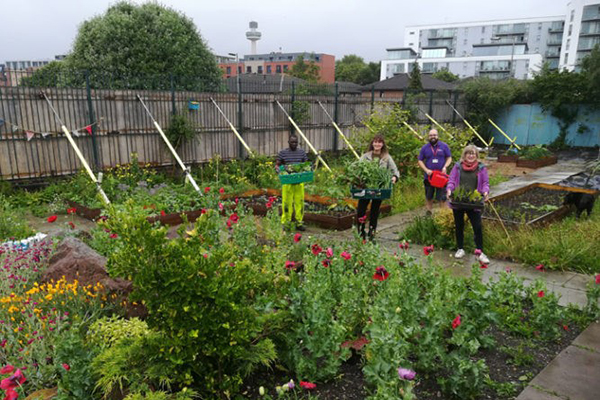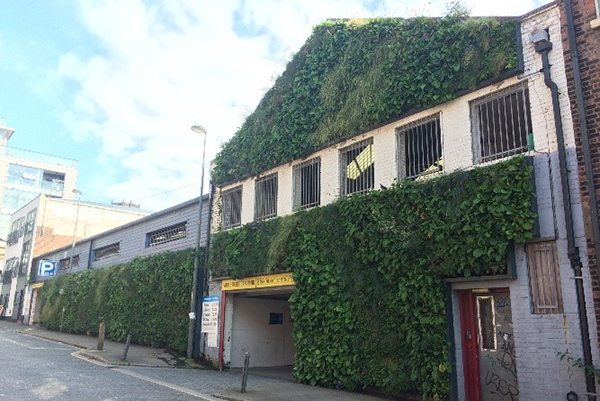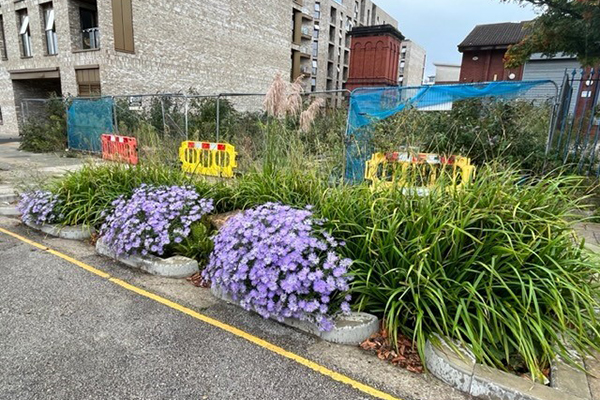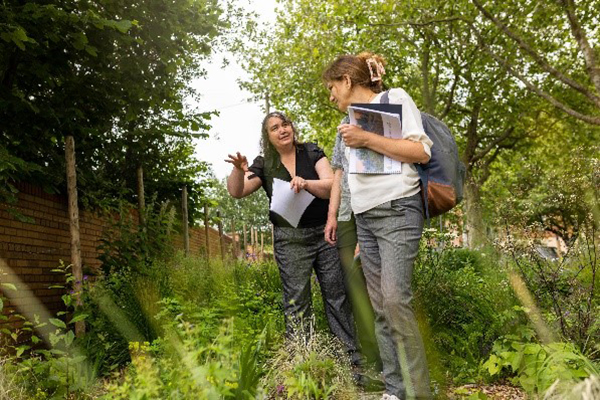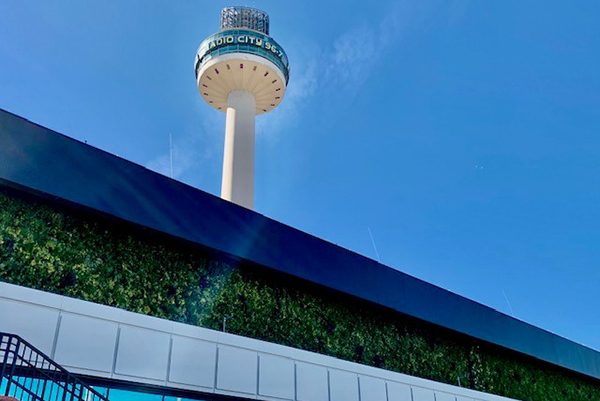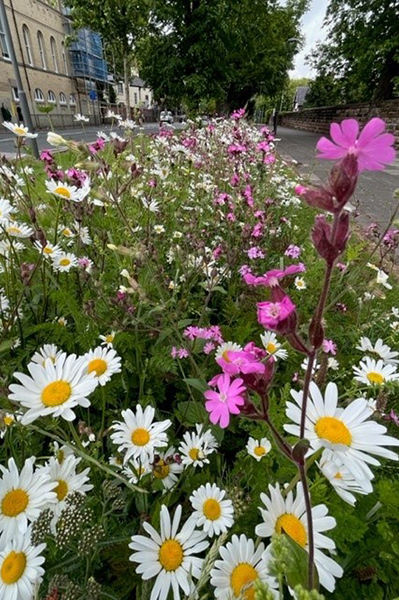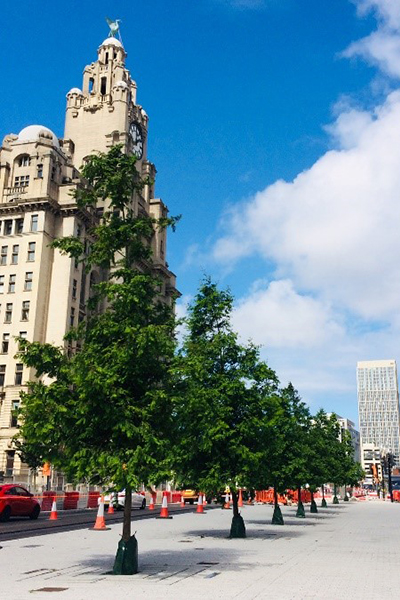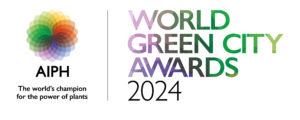Benefits of Urban Greening
Harnessing the Power of Plants
The concept of nature providing benefits is not new, but the value of ecosystem services or natural capital accounting is not widely considered or recognised in decision making processes within a UK local authority. This is partly because much of the evidence about ecosystem benefits is in scientific literature and not easily accessed.
URBAN GreenUP grasped the opportunity to address this gap in a ground-breaking way by installing a comprehensive range of NbS across the city and extensively monitoring their associated benefits. The survey programme collected data on air and water quality, pollinator and floral counts, and used established and published environmental models to calculate and predict environmental, social and economic benefits.
Data collection was designed and supervised by the University of Liverpool to create a robust and credible database. The collected, measured and modelled data over a three-year period established baseline and post intervention performance and was supplemented by social and economic surveys.
The legacy NbS sites act as working demonstrators, showing these schemes can thrive in cities and deliver long-term multiple benefits and increased city resilience. Distinctive interpretive signage raises wider public awareness and promotes the role of NbS and their many benefits.
Liverpool City Council and Mersey Forest have together successfully established many demonstrations of NbS in the city, providing a platform on which to build for the future, with the council committing to replication of works in new areas, promoting a NbS approach to tackle existing city issues and using NbS as part of future regeneration initiatives.
Delivering Multiple Benefits
The Renaturing Urban Planning (RUP) used for this initiative is an innovative way to integrate NbS into urban regeneration and city processes.
RUP begins with a baseline assessment that considers national, city and local policy and strategy. This assessment also provides an overview of social, economic and ecological resource base, as well as its current development context.
The next stage of RUP is a diagnosis, building on the evidence-base of the baseline assessment to assess the current green infrastructure (GI) network and NbS in the city. This is carried out under four themes: a sustainable city, a cool city, a healthy city and a biodiverse city. The goal of the diagnosis is to identify gaps (pinch points) in the GI network.
Once the pinch points have been identified, RUP uses an intelligence-led approach to target GI improvements for maximum benefits. For example, where pinch points overlapped for flooding and biodiversity, the installation of a rain garden as an NbS directly addressed both local surface water risk and low biodiversity. This NbS also provided wider valuable benefits including an improved streetscape aesthetic, provision of a local landmark, improved mental wellbeing, reduced flood clean-up costs, lower flood insurance premiums and an important habitat ‘stepping stone’.
Using the RUP approach to identify pinch points is the first step to identifying the best NbS for implementation. This approach is now being used to guide the development of new GI projects, raising awareness of the importance of NbS among urban planners and decision-makers.
The City’s Bold and Innovative Vision
URBAN GreenUP was a bold initiative with a vision to challenge how things had been done traditionally and demonstrate a new way of doing things to achieve better future outcomes for the city, its residents and nature. It built on previous work and laid a solid foundation for future programmes.
The initiative pioneered and tested several new technologies for NbS. The floating island in the docks was a groundbreaking innovation that has since been improved, revised and replicated. The urban raingarden was delivered through a consortium of businesses that adapted their skills for a new purpose. Other notable innovations included a room-sized mobile forest for pop-up events, a tweeting tree (Bowie the Birch) that promoted the benefits of trees, a dual-sided freestanding green wall, a solar-powered self-irrigating lamp post planter, and a sustainable low-carbon approach to pollinator planting.
Innovative monitoring technologies were used to track the impact of the URBAN GreenUP project, including solar-powered continuous air quality monitors, remote Soil Life sensors, and flow meters for tree SuDS and raingarden schemes. Data was analysed using a mix of established and emerging tools.
URBAN GreenUP developed a groundbreaking Renaturing Urban Planning (RUP) approach and used multiple geographical data layers to identify and target gaps in the urban green infrastructure network, intelligently installing the most appropriate NbS for maximum benefit. In Liverpool, the initiative delivered on a city scale, linking NbS to create new green corridors and active travel routes, providing a blueprint for sustainable future city development.
Partnerships and Collaboration
The wider URBAN GreenUp team comprised skilled stakeholders and people from across a range of internal, external, voluntary, charitable, faith, educational and business enterprises.
Broad and early consultation was key to the success of URBAN GreenUP, particularly in light of the challenges of implementing over 40 new and “untested” NbS during the COVID-19 pandemic.
Community Engagement: Officers engaged with local residents, businesses, stakeholders, community groups and councillors through public drop-in sessions, street and postal surveys, and online. A co-creation approach ensured URBAN GreenUP was responsive to the needs of the community and benefits were shared widely.
Internal Collaboration: The team maintained ongoing dialogue and consultation with city council colleagues from Highways, Legal, Procurement, Drainage, Public Health, Regeneration, Planners and Parks. This was essential to ensure the initiative met all necessary requirements and was supported by relevant stakeholders.
External Collaboration: Officers consulted with utility providers, environmental regulators and statutory bodies to secure their approval and necessary licenses and permissions. This ensured schemes were implemented in a compliant and sustainable manner.
Building Relationships and Partnerships: The initiative established new working relationships and contacts, and led to invitations for partners to speak at key city events, support requests to progress partner NbS schemes and undertake tours of the demonstration sites. Moreover, local residents volunteered to provide ongoing care for some sites, and land and property owners willingly took on the ownership and ongoing maintenance of their NbS. The Liverpool Business Improvement District also provided sponsorship for the ongoing maintenance of other NbS.
Addressing Urban Challenges
The Issue
Liverpool is using the Urban GreenUP initiative to address its climate emergency and to tackle climate related challenges, including flooding, biodiversity loss and extreme heat.
Flooding: Liverpool has the fourth-highest surface water flood risk in the UK. The city’s drainage infrastructure is 150 years old and not designed for modern-day larger populations and decreasing green space. Surface water flooding is unpredictable and circa 486,000 Liverpool residents are at risk. Moreover, there are a number of known hot-spots where many homes have been flooded and others where people have tragically died. Urban GreenUP has implemented several nature-based flood alleviation schemes, such as rain gardens, retention ponds and tree Sustainable Drainage Systems (SuDs), to reduce flood risk and improve water quality.
Biodiversity loss: Liverpool is facing a decline in biodiversity due to development and loss of habitat. The initiative has planted over 10,000 trees and shrubs across the city, creating new habitats for wildlife and improving air quality.
Extreme heat: Liverpool is experiencing hotter summers due to climate change. Urban GreenUP partners have planted trees and created green spaces to provide shade and cooling, helping to reduce the risk of heat-related illnesses.
Urban GreenUP is a valuable example of how NbS can be used to address climate change challenges. Failing to address these climate change problems now will only exacerbate the situation and create more problems in the future. The initiative has had a positive impact on Liverpool, and it is a model that can be replicated in other cities around the world.
The Impact of the Issue
Liverpool is an old city with an inadequate drainage system, making it prone to flooding. As the city has developed, green space has also been lost and fragmented, leading to a decline in biodiversity.
These problems are having a significant impact on Liverpool’s residents, especially those residents living in urban areas with multiple indices of deprivation, who often experience higher rates of respiratory and cardiovascular disease.
People living in these areas are more vulnerable to the impacts of climate change, particularly flooding, heat waves and poor air quality. They are also less financially resilient and often unable to afford insurance or recover from flooding.
Businesses have also been adversely affected by flooding, heat waves, and extreme weather.
A Nature-Orientated Future
URBAN GreenUP is using NbS to help address these challenges.
Liverpool has trialled a sustainable urban tree drainage scheme, water retention ponds and the first urban city raingarden. These NbS help to control water flow, movement and flood risk, making the city and its residents more resilient to climate change impacts.
Tree and planting projects have also been used to reduce air temperatures, capture and store carbon, and provide stepping-stones or new areas of biodiversity. This helps to enhance sites and make the city a better place to live for everyone.
URBAN GreenUP is a valuable example of how nature can be used to create a better city. It is helping to address the challenges of climate change and improve the lives of Liverpool’s residents.
Nature Positive Solutions
Implementation
URBAN GreenUP (2017-2023) is a pioneering initiative that uses NbS to address a range of challenges facing Liverpool, including flooding, air pollution, biodiversity loss, and physical and mental health.
The initiative has installed and monitored over 40 NbS across the city, including rain gardens, green roofs and urban tree planting. There was an added focus on retrofitting NbS into existing city structure. These NbS are already having a significant impact on the city’s environment and wellbeing as data shows:
Environmental benefits:
- Over 5,200,000 litres of water diverted from sewers.
- Air surface temperature reductions of up to 7.5oC on hot days.
- Cleaner air with a reduction of particulate matter and nitrogen dioxide.
- Improved water quality with the removal of some heavy metals and nutrients.
- Enhanced biodiversity with pollinator counts up 920% at one site.
Social benefits:
- Accessible green routes with less pollution and enhanced active travel.
- Improved mental health and wellbeing.
- Community-focused initiatives, such as the promotion of the iNaturalist species identification app, physical and mental health programmes, citizen science events and volunteer opportunities.
Economic benefits:
- 82% of businesses see greening as beneficial.
- 94% of businesses rate green areas twice as highly.
- 92% of businesses think street trees attract footfall and trade.
URBAN GreenUP is a shining example of how nature can be used to solve some of the most pressing challenges facing cities today. The initiative is already making a real difference in Liverpool and it is a model that can be replicated in other cities around the world.
Feasibility
URBAN GreenUP has demonstrated its feasibility and success in a number of ways:
Longevity: Careful consideration was given to the longevity of the interventions at the outset. Some were incorporated into council maintenance programmes, while others were adopted by third-party land and business owners through legal agreements. Community groups also adopted some sites, and business sponsorship was secured for another.
Replication: The work can be simply and cheaply replicated in many locations as demonstrated by the recent replication of some small schemes under a separate follow-on funded Green Recovery project. Impact: The success of URBAN GreenUP led to changes in the city’s approach to regeneration schemes, supported by recent legislative changes in Biodiversity Net Gain and Local Nature Recovery Strategies. There have been positive changes to city tree planting, with new specification requirements for tree soil volumes and preferred planting species. The pollinator works demonstrated how to deliver chemical-free, sustainable, low-carbon and low-maintenance planting on difficult spaces. Businesses, such as Liverpool ONE, also sought to extend the works by considering new NbS schemes for their estate and tenant properties.
URBAN GreenUP also secured funding from a variety of sources, including the European Regional Development Fund, the National Lottery Heritage Fund, and the Environment Agency, demonstrating it was seen as a viable and worthwhile investment by a range of funders.
Overall, it has provided strong evidence that NbS are feasible and effective in both the short and long term in addressing a range of urban challenges.
Multi-Stakeholder Support
URBAN GreenUP was designed and implemented with active engagement of many stakeholders, including residents, community groups, businesses and government agencies. This ensured that the initiative was responsive to the needs of the community and benefits were shared widely.
Specific examples of how the initiative engaged and supported stakeholders include:
Faiths4Change: The initiative assisted this local charity in clearing an overgrown plot to create a small church garden, which has developed into a larger food growing area. This created a sustainable livelihood for the charity and a valuable resource for the local community. The project has provided training to local people on horticultural skills and offered placements for social workers.
Friends of Park Groups: URBAN GreenUP worked with ‘Friends of Park’ groups to support integrated civil and NbS works to reduce flooding in parks. This created opportunities to make parks more accessible and to add wildflower planting and bird/bat boxes. One group even trained in water safety to care for a freshwater island.
Local Landscape Design Contractor: The initiative engaged with local landscape design contractor ‘ReShaped’ to experiment with sustainable approaches for biodiversity planting. ReShaped is now developing its landscape business to promote and deliver similar work, making this a niche area for the future.
Large Retailer: URBAN GreenUP partnered with large retailer Liverpool ONE to launch follow-on greening work across the wider estate and with its commercial buildings and tenants.
URBAN GreenUP’s success is a testament to the importance of stakeholder engagement in the planning and implementation of urban greening initiatives.
Management and Maintenance
URBAN GreenUP projects were carefully designed and implemented to ensure that the NbS would be as sustainable as possible in the longer term and require minimal maintenance and management through:
Stakeholder engagement: Opportunities were provided for staff and partners to shadow maintenance visits. Short and long-term maintenance manuals were developed as part of the brief. This engagement helped ensure that all stakeholders were aware of their maintenance responsibilities and that the necessary skills and knowledge were in place.
Sustainable design: The pollinator works planting schemes were designed to embrace and work with the habitat location. Planting mixes were put together to provide life cycle forage and habitat for pollinator species, and care was taken to ensure that the initial planting density and planting components would grow together, outcompete weeds, and form a low-maintenance succession community that continued to provide benefits with minimal interventions.
Contingency planning: A 10% contingency spend and longer project delivery times were added to the overall budget to allow for unexpected costs and delays. This helped to overcome challenges and deliver the desired outcomes.
The team also demonstrated a willingness to adapt and be creative in the face of challenges. For example, when an unmapped manhole was discovered where a pond was to be installed, the team redesigned the pond to be smaller but more aesthetically pleasing. Similarly, when a raingarden with a tree had to be removed due to site limitations and excavation costs, the team was able to create a more attractive planting design.
Measuring and Reporting Impact
Monitoring Results
URBAN GreenUP was underpinned by a comprehensive monitoring framework based on 40 EU EKLIPSE key performance indicators, covering a range of environmental, social and economic parameters. This framework ensured that progress and impact could be tracked and areas identified for improvement.
Data was collected by a dedicated monitoring officer using standard methodologies, either directly from the source or using modelling tools. New monitoring technologies were also tested, including remote, solar-powered, continuous air quality monitors and Soil Life sensors retrofitted in tree SuDS and raingardens.
In May 2023, all baseline and monitoring data was uploaded to the EU Zenodo database for open access, and a free, easy-to-use data portal was hosted by Liverpool for the city data. This data sharing will enable researchers and practitioners around the world to learn from the URBAN GreenUP experience and replicate successful schemes elsewhere.
The initiative also produced complementary case studies for each NbS, providing information on costs, procurement, challenges and benefits evidenced by the data. These case studies will provide valuable guidance for other cities and stakeholders considering implementing similar schemes.
Overall, the URBAN GreenUP’s robust monitoring framework and open access data sharing are valuable contributions to the field of urban greening. This work will help to ensure that the benefits of NBS are realised in cities around the world.
Demonstrating Progress
URBAN GreenUP placed a strong emphasis on monitoring and evidence-building, recognising the importance of demonstrating the value and benefits of NbS to stakeholders.
The comprehensive monitoring framework tracked the performance of NbS interventions against a range of environmental, social and economic indicators. This data has been used to develop compelling case studies that quantify the multiple benefits of NbS in real-world settings.
The case studies and lessons learned from Liverpool have been shared widely with other cities and partners around the globe, both in person and online. This has helped to build a strong business case for replicating NbS works elsewhere.
The evidence generated by the initiative has also been instrumental in securing follow-on funding for green infrastructure projects in Liverpool. For example, from DEFRA and HLF under the Green Recovery programme. Under this smaller programme of works, we replicated works at five sites, recreating floating ecosystem islands in a park lake to improve water quality, developing a cheap growing green wall at a food hub, creating a water SuD in a park, installing shady pollinator walkways in a park and creating colourful pollinator spaces in a key city location.
Going forward having established the costs and benefits of many of the NbS we are in a strong position to influence regeneration schemes, seek additional funding and direct the spend of Section 106 developer monies for improvements in city green and urban spaces.
URBAN GreenUP has demonstrated that NbS can be a cost-effective and climate-resilient approach to addressing urban challenges.
Measuring Impact
URBAN GreenUP has had a significant impact on Liverpool, and its findings are being shared widely through a combination of measured, modelled and story data.
Measured data is collected through comprehensive monitoring that tracks the performance of NbS interventions against environmental, social and economic indicators, and quantifies multiple benefits:
- 155,000kgCO2e sequestered by trees (507kgCO2e sequestered by other land changes)
- Energy savings from cooling (298kw/hour/year) with associated avoided carbon emissions of 149kg CO2
- 5,200,000 litres/year of stormwater diverted from the sewer
- 26 lives saved/year (increased walking and pollution reduction)
- 817 more houses have a greenspace view
- 0.16 hectares added biodiversity
- Air pollution reductions (0.01t/year ozone and 0.01t/year PM2.5)
- 20 new volunteers
- 500,000 local users
- 100,000 visitor tourist days
- 60 new FTE jobs (tourism)
- 2 FTE jobs (land management)
- Reduced absenteeism between 9,070–48,400 days/year
Modelled data predicts long-term benefits of NbS and identifies areas for effective NbS deployment such as a 7.5oC reduction in peak summer surface temperatures.
Story data brings the human dimension to life. This includes personal stories of community engagement, descriptions of evolving spaces and places created, and accounts of unexpected benefits that have emerged, such as the establishment of new food webs in pollinator spaces.
The URBAN GreenUP story is captivating and vast, and can be adapted to suit any audience. Its impact is inspiring other cities to embrace NbS for more sustainable and liveable urban environments.
Data is reported to the EU website, on the Liverpool portal, and is publicly available free of charge.
Learning and Transferability
Adaption and Enhancement
Delivery of Urban GreenUP took place in a complex and challenging environment. Several schemes required amending and redesign during implementation to accommodate unforeseen obstacles, such as unmapped utilities and landscape features. The team demonstrated flexibility and resilience in overcoming these challenges.
For example, the lower water retention ponds were redesigned to avoid an unmapped manhole, and a raingarden bed was reduced in depth to avoid excessive excavation costs. A green wall required additional structural support, tree locations needed to be revised to accommodate underground cables and utilities, and the prototype floating island benefited from upgrades following its installation.
The team also collaborated effectively with external stakeholders. For example, a landscape architect fully embraced the idea of sustainably planting five difficult city sites for biodiversity and pollinators. As a result, the work was re-scoped to trial hydroseeding on a concrete slipway, innovative ways of site preparation without chemicals (flame thrower, acetic acid or vinegar solution, deep turf stripping), reuse of materials between sites, use of other reclaimed materials, and organically sourced plants, bulbs, turf and seed. The contractor has now made this a key aspect of her business.
In addition, volunteers helped to maintain the sites in their first year when hand-weeding and irrigation were needed to establish the planting mixes. The engagement of a large retailer, Liverpool ONE, on a dual-sided green wall initiative also helped to profile and promote the value of NbS to tenants and shoppers and formed the basis for additional NbS in the wider estate.
Potential for Replication
URBAN GreenUP has had a significant ripple effect in Liverpool and beyond.
Early Successes: Initial ripple effects were noted after the installation of early larger works such as green walls and floating islands. Developers made contact to inquire about potential replication, sites were used for filming, and images were used in policy documents.
There have also been longer-term impacts:
Pollinator schemes: The city’s pollinator schemes have been particularly successful, transforming difficult sites into spectacular, low-maintenance exemplars. The schemes were delivered sustainably, using organically sourced planting mixes selected for longevity, colour, scent and pollinator value. The diversity and impact of these sites has created a wave of ongoing interest. The contractor has run volunteer and teaching sessions with community groups, city council maintenance staff and local businesses.
Tree Sustainable Urban Drainage System (SuDS): The success of these has attracted much interest and options to replicate elsewhere are now being explored.
City raingarden: The city’s first urban raingarden has enthused many and the consortium of contractors continues to promote it. Many more raingardens now feature in future public realm plans.
Faiths4Change: The charity has turned its planted garden into a church allotment to grow food for the local food bank, as well as offering horticultural training courses.
Site tours: There is a continued demand, with inquiries from Germany, USA, Hong Kong, and closer to home from city planners and climate change staff. These tours have provided a great opportunity for “show and tell” and to support others wanting to make similar changes.
Inspiring Other Cities
URBAN GreenUP has attracted attention and interest from around the world, showcasing the innovative potential of NbS to address urban challenges in a changing climate and inspiring others to raise their greening ambitions.
The floating island in Liverpool docks has been a particular source of interest, with enquiries from Vietnam, Romania, Seattle, a First American Indian tribe and India. These have focused on adapting the design to meet a variety of local needs, such as food production, growing medicinal plants, habitat provision or coastal protection.
The initiative also had a formal mentoring aspect, with Liverpool’s work regularly shared with follower cities in China, Germany, Italy, South America and Vietnam. Additionally, 26 network cities across the globe were invited to webinars specifically designed to address key areas of interest, such as site preparation, project implementation, maintenance and monitoring, water interventions, early data insights and challenges.
All of the webinars and a range of documentation on deliverables, such as procurement and technical specifications, along with decision-making tools, are available to download for free: www.urbangreenup.eu
Resilience
Reducing Negative Impacts and Ensuring Sustainability
URBAN GreenUP committed to reducing its carbon footprint at every stage of implementation in the following ways:
Materials: Natural materials, such as coconut coir rolls and lightweight expanded clay aggregate were used as planting media in the floating island structure, along with recycled plastic buoyancy units.
Water: Rainwater harvesting was used for the green walls where possible.
Reuse: Removed turf was reused at a nearby park, and aggregate materials were reused between sites. City centre paving was reclaimed for pollinator walkways.
Sourcing: Organic seeds, bulbs, plants and turf were sourced without plastic wrapping or in returnable trays. Locally provided compost, mulch and bark were used.
Recycling: Recycled materials were used for a habitat art trail.
Local employment: Local consultants and contractors were employed where possible.
Maintenance: Hand weeding was used to maintain the sites.
In addition to reducing its carbon footprint, URBAN GreenUP also sought to design-out anti-social behaviour (ASB). For example, a mesh cover was considered for accessible green walls, but it was not needed as the walls were not damaged, even though one is located on a road serving late night bars and clubs. The adoption of tree containers by the local Chinese community with celebratory New Year wrappers on the containers reduced graffiti and litter. Distinctive signage at sites with logos of multiple partners hinted at ownership, and regular weeding by volunteers also helped to reduce ASB. Sponsorship helped to maintain some sites with regular investment and team building days.
Environmental Considerations
The team committed to sustainable planting schemes and procurement of materials and services.
Planting schemes were designed for longevity, with trees that could survive for over 100 years in situ and pollinator schemes that evolved over time to outcompete weeds.
Species selection was dictated by a range of factors, including soil nutrients, pH, and texture, current and future climates, location, natural water availability, slope, colour, nectar and habitat benefits, and plant function and purpose. Some plants needed to be tolerant of wet and dry conditions, while others had phytoremediation properties.
Pollinator planting included a mix of native and non-native species, with early and late bulbs to extend the nectar season. Thought was also given to providing a complete ecosystem and forage for all stages of pollinator lifecycles.
Sustainable Practices – to further minimise impact, the URBAN GreenUP team championed a no-chemical approach. Materials on site were reused or reclaimed, some seeds were collected locally, and habitats created reflected their locations.
Energy costs and carbon savings were made either through local procurement to reduce fuel miles, a reduction in mowing to reduce fuel consumption, or the thermoregulatory benefits on buildings benefitting from exterior green walls or direct tree shading. Other initiatives used solar power for irrigation and data collection.
Sustainable Procurement: specifications included direct questions on sustainable approaches, and the cost/quality scoring ratio was adjusted to favour quality over cost.
Consultants, contractors and materials were all sourced locally as far as possible.
Use of Natural Resources
The team were committed to sustainable practices throughout implementation, from the design of its planting schemes to the materials and methods used on site.
Water Conservation: Rainwater harvesting was used for irrigation on green roofs and planting schemes whenever possible. This reduced water demand and saved energy on pumping and treatment.
Composting materials were brought in locally from council depots. This helped to reduce the project’s carbon footprint and support the local economy.
Material Reuse: Pathways through the pollinator sites were created from reclaimed council pavers. Many materials were reused between the pollinator sites to form a closed loop with very little needing to be taken off site. This reduced overall waste production and environmental impact.
Sustainable Sourcing: Plants, seeds, turf and bulbs were sourced organically and without plastic wrapping or delivered on reusable or returnable trays and containers. Thus, reducing reliance on single-use plastics and supporting sustainable agriculture practices.
Non-Chemical Weed Control: Non-chemical approaches were trialled for site preparation, including flame throwers, deep turf stripping (and reuse elsewhere), and solutions of acetic acid to remove unwanted broadleaved weeds. This helped to reduce the project’s reliance on herbicides and protect the environment.
Soil Moisture Conservation: Jute covering was used to help retain soil moisture on pollinator sites, reducing demand for water and making the sites more resilient to drought conditions.
Floating Island Design: This included innovative surface features, including lined shallow trays so that plants that were not tolerant to 100% seawater could capture rainwater for irrigation and survival.

















